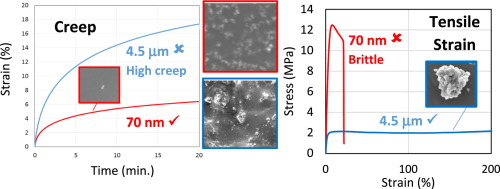Journal of Colloid and Interface Science ( IF 9.4 ) Pub Date : 2018-03-22 , DOI: 10.1016/j.jcis.2018.03.067 D.K. Makepeace , P. Locatelli , C. Lindsay , J.M. Adams , J.L. Keddie

|
Hypothesis
Colloidal polymer composites, in which polymer particles are blended with a filler, are widely used in applications including pharmaceuticals, crop protection, inks, and protective coatings. It is generally found that the presence of hard particulate fillers will increase the elastic modulus of a polymer colloid composite. However, the influence of the size of the filler particle on the large-strain deformation and fracture and on the viscoelastic characteristics, including creep, is not well explored. We hypothesize that the size ratio of the filler to the colloidal polymer will play a critical role in determining the properties of the composite.
Experiments
Colloidal composites were prepared by blending soft polymer colloids (as a binder) with calcium carbonate fillers having four different sizes, spanning from 70 nm to 4.5 μm. There is no bonding between the filler and matrix in the composites. The large-strain deformation, linear viscoelasticity, and creep were determined for each filler size for increasing the filler volume fractions (ϕCC). Weibull statistics were used to analyze the distributions of strains at failure.
Findings
We find that the inclusion of nano-fillers leads to brittle fracture at a lower ϕCC than when μm-size fillers are used. The data interpretation is supported by Weibull analysis. However, for a given ϕCC, the storage modulus is higher in the rubbery regime, and the creep resistance is higher when nanoparticles are used. Using scanning electron microscopy to support our arguments, we show that the properties of colloidal composites are correlated with their microstructure, which can be altered through control of the filler:polymer particle size ratio. Hard nanoparticles pack efficiently around larger particles to provide reinforcement (manifested as a higher storage modulus and greater creep resistance), but they also introduce weak points that lead to brittleness.
中文翻译:

胶态聚合物复合材料:纳米填料是否总是更好地改善机械性能?
假设
胶体聚合物复合材料(其中聚合物颗粒与填料共混)广泛用于包括药物,农作物保护,油墨和保护性涂料的应用中。通常发现,硬质颗粒状填料的存在将增加聚合物胶体复合物的弹性模量。但是,填料颗粒的尺寸对大应变变形和断裂以及包括蠕变在内的粘弹性特征的影响尚未得到很好的研究。我们假设填料与胶体聚合物的尺寸比将在决定复合材料的性能方面起关键作用。
实验
通过将软聚合物胶体(作为粘合剂)与碳酸钙填充剂混合,制备胶体复合材料,碳酸钙填充剂的尺寸从70 nm到4.5μm不等。复合材料中的填料和基体之间没有粘结。大应变变形,线性粘弹性,和蠕变对每个填料尺寸用于增加填料体积分数(确定φ CC)。使用威布尔统计数据分析失效时的应变分布。
发现
我们发现,包括纳米填料导致的脆性断裂在较低φ CC当使用微米大小的填料比。数据解释得到威布尔分析的支持。然而,对于给定φ CC,在橡胶态下的储能模量更高,而当使用纳米颗粒时,其抗蠕变性更高。使用扫描电子显微镜来支持我们的论据,我们表明,胶体复合材料的性能与其微观结构相关,可以通过控制填料:聚合物粒径比来改变。硬质纳米颗粒可以有效地堆积在较大的颗粒周围,以提供增强作用(表现为较高的储能模量和较高的抗蠕变性),但它们还会引入导致脆性的弱点。











































 京公网安备 11010802027423号
京公网安备 11010802027423号